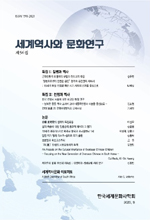조선 후기 <해도(蟹圖)> 연구 - 조선시대 게 그림
Study on <Haedo(蟹圖)> of the Late Joseon Dynasty : Crab Paintings of the Joseon Dynasty
- 한국세계문화사학회
- 세계역사와 문화연구
- 제72집
-
2024.0979 - 110 (32 pages)
-
DOI : 10.32961/jwhc.2024.09.72.79
- 78

‘게’를 그린 해도(蟹圖)는 장원급제 축원 등 길상적인 의미로 주로 그려졌다. 그 연원은 중국 오대·북송 시기로 거슬러 올라가며, 명대에는 심주, 서위 등 오파(吳派)에 의해 문인화풍 해도가 그려지면서 성행하게 된다. 문인화풍 해도는 시적 정취와 함께 묵의 농담에 따른 선염의 효과를 낸 수묵·몰골법으로 ‘게’를 그린 것으로, 중국 청대와 근현대는 물론 조선에까지 파급되면서 동아시아 해도에 지대한 영향을 끼친다. 우리나라에 해도가 정확히 언제 유입되었는지는 알 수 없지만, 늦어도 고려시대에는 여러 물고기 도상과 함께 ‘게’가 그려졌을 것으로 추측된다. 그러나 해도가 본격적으로 그려진 것은 명대 문인화풍 해도가 유입된 이후로, 김인관, 심사정, 최북, 김홍도 등 조선 후기를 대표하는 화가들이 해도를 즐겨 그렸다. 특히 김홍도는 서위 화풍의 영향 아래 독창적인 요소를 가미해 회화성 짙은 작품을 다수 남겼고, 후배 화가들의 해도에 커다란 영향을 미치게 된다. 한편, 19세기 다양한 사회·문화적 배경과 맞물려 공필과 채색을 이용해 묘사 대상을 사실적으로 그려낸 새로운 양식의 해도가 장한종에 의해 시도된다. 장한종은 치밀한 사생에 근거한 도보(圖譜)를 연상시키는 극사실주의 화풍으로 각 어종의 외양과 생태까지 정확히 담아내었다. 그는 중국에서도 그 예를 찾기 힘든 독자적인 병풍 형식의 어해도를 창안하였으며, 이는 후대 화가들의 작품에 많은 영감을 주었다. 이같이 조선 후기 해도는 중국 해도의 단순한 모방에 그친 것이 아니라, 김홍도와 장한종의 예처럼 다양한 응용과 새로운 시도를 통해 독창적이고 개성적인 특성을 갖추어나가 조선 말기는 물론 근대까지도 그 전통이 계승되어 하나의 화제로 온전히 자리매김할 수 있었다.
Crab paintings referred to as Haedo(蟹圖) were mainly drawn with auspicious meanings such as congratulations on passing the state examination. Its origins date back to the Five Dynasties and Northern Song periods in China, and Haedo became popular during the Ming Dynasty when Wu or Wumen School, including Shen Zhou and Xu Wei, started drawing them in the style of literary painting. Literary style Haedo refers to a crab painting with poetic sentiment produced by an ink-and- wash/boneless brush technique for the light-and-shade effect; it greatly influenced East Asian Haedo from the Qing Dynasty of China to modern times and even to Joseon. Exactly when Haedo was first introduced into Korea is unknown, but it is thought that crabs were drawn along with various fish icons at the latest during the Goryeo Dynasty. However, Haedo was drawn in earnest after the introduction of the literary style Haedo during the Ming Dynasty, and painters representing the late Joseon Dynasty, such as Kim In-gwan, Shim Sa-jeong, Choi Buk, and Kim Hong-do, enjoyed drawing them. In particular, Kim Hong-do left behind many works with strong pictorial qualities by adding original elements under the influence of Xu Wei, which greatly influenced the paintings of later painters. Popular throughout the late Joseon Dynasty, the literary style Haedo expanded as far as folk paintings, and the tradition was passed down from the late Joseon Dynasty to modern times. Meanwhile, apart from how the literary style Haedo was developed, a new style of realistically depicting the subject with fine brushes, intertwined with various social and cultural backgrounds, was attempted by Jang Han-jong, a painter at the Dohwaseo (court painting institution), in the 19th century. Jang Han-jong accurately captured the appearance and ecology of each fish species with a hyper-realistic painting style based on detailed sketches that were even reminiscent of a collection of illustrations, and he also created fish and crab paintings in the form of folding screens, which inspired later painters.
Ⅰ. 머리말
Ⅱ. 해도의 연원과 전개
Ⅲ. 조선 후기 해도의 양식과 특징
Ⅳ. 맺음말
(0)
(0)